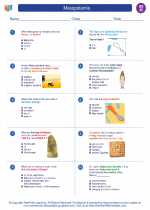Babylonians
The Babylonians were an ancient civilization that existed in Mesopotamia, in the region of present-day Iraq. They are known for their contributions to mathematics, astronomy, and law, as well as their impressive architectural achievements.
Key Points:
- Location: The Babylonian civilization was centered in the city of Babylon, which was located on the Euphrates River.
- Contributions to Mathematics: The Babylonians developed a number system based on the number 60, which is why we have 60 seconds in a minute and 60 minutes in an hour. They also made significant advances in geometry and algebra.
- Contributions to Astronomy: Babylonian astronomers were among the first to make systematic observations of the heavens. They created a calendar based on the phases of the moon and were able to predict lunar and solar eclipses.
- Code of Hammurabi: One of the most famous achievements of the Babylonians was the Code of Hammurabi, a set of laws that established the principle of "an eye for an eye" and provided guidelines for legal and social behavior.
- Architecture: The Babylonians are known for their impressive ziggurats, which were massive stepped pyramids that served as religious temples.
Study Guide:
Use the following questions to guide your study of the Babylonians:
- Where was the Babylonian civilization located?
- What were the Babylonians' contributions to mathematics?
- How did Babylonian astronomers make use of their observations of the heavens?
- What was the Code of Hammurabi and why is it significant?
- What are some examples of Babylonian architecture?
By exploring these questions, you can gain a deeper understanding of the Babylonian civilization and its impact on human history.
[Babylonians] Related Worksheets and Study Guides:
.◂Social Studies Worksheets and Study Guides Eighth Grade. Mesopotamia
Study Guide Mesopotamia
Mesopotamia  Worksheet/Answer key
Worksheet/Answer key Mesopotamia
Mesopotamia  Worksheet/Answer key
Worksheet/Answer key Mesopotamia
Mesopotamia  Worksheet/Answer key
Worksheet/Answer key Mesopotamia
Mesopotamia 

 Worksheet/Answer key
Worksheet/Answer key
 Worksheet/Answer key
Worksheet/Answer key
 Worksheet/Answer key
Worksheet/Answer key

The resources above cover the following skills:
National Curriculum Standards for Social Studies (NCSS)
TIME, CONTINUITY, AND CHANGE
SOCIAL STUDIES PROGRAMS SHOULD INCLUDE EXPERIENCES THAT PROVIDE FOR THE STUDY OF THE PAST AND ITS LEGACY.
KNOWLEDGE - Learners will understand:
Key historical periods and patterns of change within and across cultures (e.g., the rise and fall of ancient civilizations, the development of technology, the rise of modern nation-states, and the establishment and breakdown of colonial systems).
National Center for History in Schools (NCHS)
Historical Thinking Standards
Historical Comprehension
Reconstruct the literal meaning of a historical passage.
World History Content Standards
Era 2: Early Civilizations and the Emergence of Pastoral Peoples, 4000-1000 BCE
The major characteristics of civilization and how civilizations emerged in Mesopotamia, Egypt, and the Indus valley.
The student understands how Mesopotamia, Egypt, and the Indus valley became centers of dense population, urbanization, and cultural innovation in the fourth and third millennia BCE.
The student understands how commercial and cultural interactions contributed to change in the Tigris-Euphrates, Indus, and Nile regions.
How agrarian societies spread and new states emerged in the third and second millennia BCE.
The student understands how new centers of agrarian society arose in the third and second millennia BCE.
Major trends in Eurasia and Africa from 4000-1000 BCE.
The student understands major trends in Eurasia and Africa from 4000 to 1000 BCE.